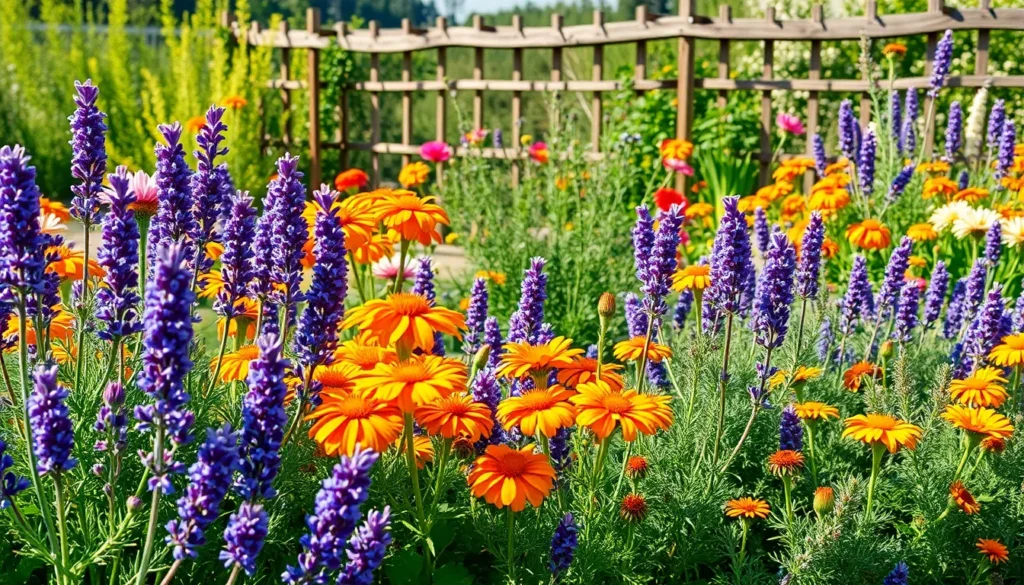Nothing’s more frustrating than watching deer turn your carefully curated garden into their personal buffet. We’ve all been there – you plant beautiful flowers and vegetables only to wake up and find them nibbled down to stubby stems. The good news? You don’t have to surrender your outdoor space to these graceful yet persistent garden raiders.
Deer-resistant plants are your secret weapon for creating a stunning industry that stays intact. These strategic botanical choices naturally repel deer through their strong scents, bitter tastes, or tough textures. By selecting the right varieties, we can outsmart these four-legged garden crashers while still enjoying vibrant colors and lush foliage.
Whether you’re dealing with urban deer populations or countryside visitors, the solution isn’t complicated fencing or expensive deterrents. It’s simply choosing plants that deer find unappetizing. Let’s explore the most effective deer-proof options that’ll keep your garden gorgeous and intact season after season.
Understanding Why Deer Avoid Certain Plants
Deer possess remarkable survival instincts that guide their feeding choices throughout different seasons. We’ve discovered that these animals rely on exact sensory cues to determine which plants are safe to consume and which ones they should avoid.
Strong Scents and Aromatic Properties
Aromatic plants create natural barriers that deer instinctively avoid due to their powerful essential oils. These fragrant compounds trigger deer’s sensitive olfactory systems, sending warning signals that these plants may be dangerous or unpalatable. Lavender, rosemary, and sage release potent oils that mask the scent of other nearby plants while creating an unwelcome environment for browsing deer.
Pungent herbs like garlic, chives, and onion family plants produce sulfur compounds that deer find offensive. These strong-smelling chemicals evolved as natural defense mechanisms, and deer have learned to associate these scents with potential toxicity. We’ve observed that even small amounts of these aromatic plants can protect entire garden beds from deer browsing.
Mint family plants release menthol and other volatile oils that irritate deer’s sensitive nasal passages. Species like peppermint, spearmint, and catnip produce these compounds in their leaves and stems, creating an invisible shield around your garden. The cooling sensation that humans enjoy from menthol actually causes discomfort for deer, making these plants excellent natural deterrents.
Toxic or Bitter Compounds
Poisonous plants contain alkaloids and glycosides that deer recognize as life-threatening substances. Foxglove, oleander, and daffodils produce these toxic compounds as evolutionary protection against herbivores. Deer have developed an innate ability to detect these dangerous chemicals through smell and taste, avoiding them entirely to prevent illness or death.
Bitter-tasting plants produce tannins and other astringent compounds that create unpleasant eating experiences. Barberry, holly, and certain ornamental grasses contain high levels of these bitter substances that make chewing difficult and leave an undesirable aftertaste. These natural chemicals serve as the plant’s first line of defense against browsing animals.
Milky sap and latex-producing plants release sticky, often toxic fluids when damaged. Euphorbias, milkweeds, and certain succulents produce these protective substances that can irritate deer’s mouths and digestive systems. We’ve found that deer quickly learn to avoid these plants after experiencing the unpleasant effects of their defensive secretions.
Texture and Mouthfeel Preferences
Spiny and thorny plants create physical barriers that deer prefer to avoid rather than navigate. Roses, barberry, and holly shrubs present sharp obstacles that can injure deer’s tender mouths and tongues during feeding. These defensive structures make the energy cost of eating these plants higher than the nutritional benefit they provide.
Fuzzy and hairy leaves feel uncomfortable in deer’s mouths and can interfere with proper chewing. Plants like lamb’s ear, dusty miller, and certain salvias have developed these textural defenses to discourage herbivore browsing. The soft, velvety texture that appeals to human touch actually creates an unpleasant mouthfeel for deer.
Thick, leathery leaves require more energy to chew and digest than deer prefer to expend. Rhododendrons, boxwood, and certain evergreen shrubs have tough, waxy foliage that resists easy consumption. Deer typically choose softer, more tender vegetation over these challenging textures when other food sources are available.
Fragrant Herbs That Deer Will Not Eat
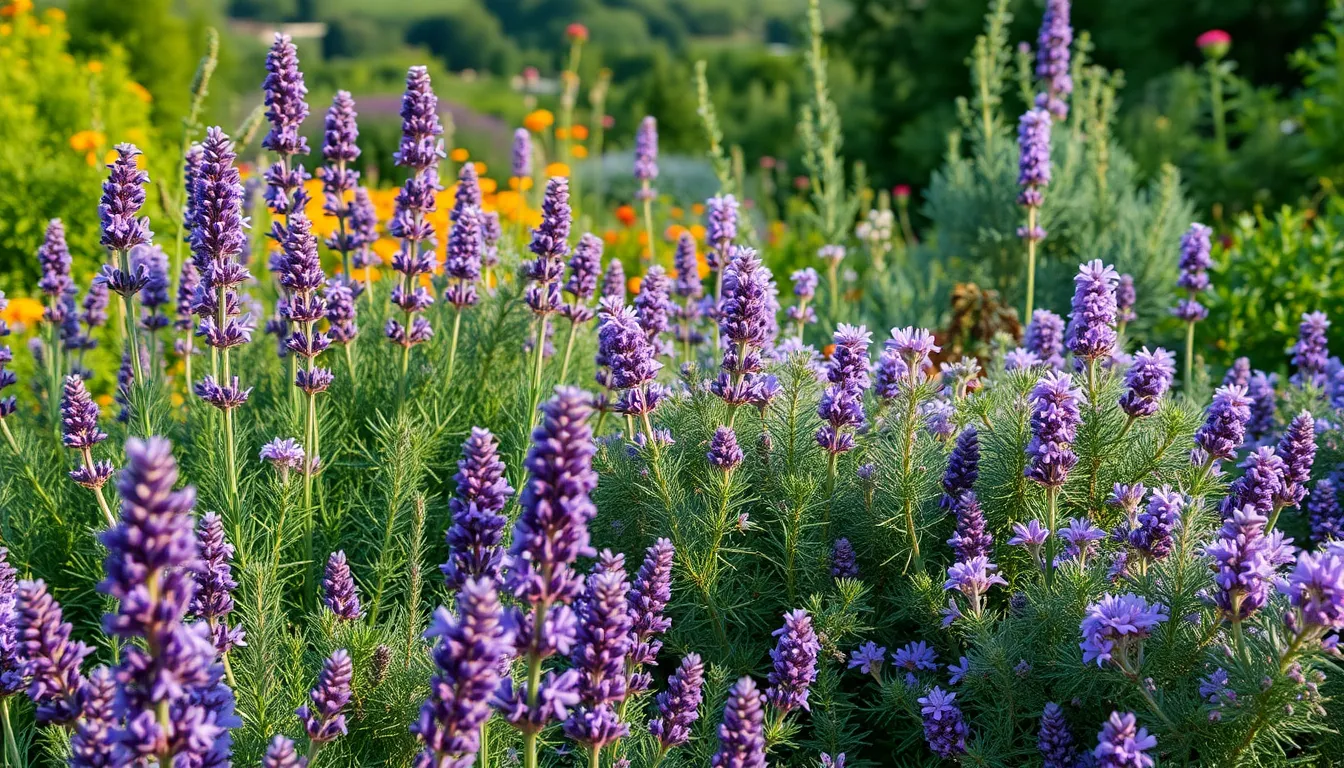
We’ve found that aromatic herbs create some of the most effective natural barriers against deer in our gardens. Strong scented herbs work exceptionally well because deer rely heavily on their sense of smell to identify safe food sources.
Lavender and Its Varieties
Lavender stands out as one of our most reliable deer resistant plants due to its powerful aromatic oils that deer find completely unappealing. Various Lavandula species thrive in full sun and well drained soils while providing both beauty and protection for our gardens. Hardy perennial varieties like English lavender and French lavender offer year round deer resistance with their distinctive fragrance. We recommend planting lavender along garden borders or pathways where its scent can create a natural deterrent zone. Purple flower spikes add visual appeal throughout the growing season while maintaining their deer repelling properties.
Rosemary and Mediterranean Herbs
Rosemary serves as another Mediterranean powerhouse for deer resistance with its volatile oils and tough needle like leaves that deer consistently avoid. Rosmarinus officinalis thrives in drought conditions while providing culinary value and natural deer protection for our landscapes. Additional Mediterranean herbs including thyme, sage, and French tarragon share similar aromatic foliage traits that contribute to their effectiveness against deer browsing. We often interplant these herbs throughout our gardens to create multiple layers of natural deer repellency. Drought tolerant characteristics make these herbs particularly valuable in areas where we want low maintenance deer protection.
Mint Family Plants
Catmint emerges as our top choice among mint family plants for deer resistance due to its exceptionally strong scent that deer actively dislike. Nepeta species provide hardy perennial coverage while attracting beneficial pollinators that deer naturally avoid. Common mints including spearmint and peppermint contain aromatic compounds that serve as natural repellents throughout the growing season. We’ve observed that planting mint family varieties creates an unfavorable browsing environment that encourages deer to seek food elsewhere. These plants spread readily to form dense patches that amplify their deer deterrent effects across larger garden areas.
Spiky and Thorny Plants That Deter Deer
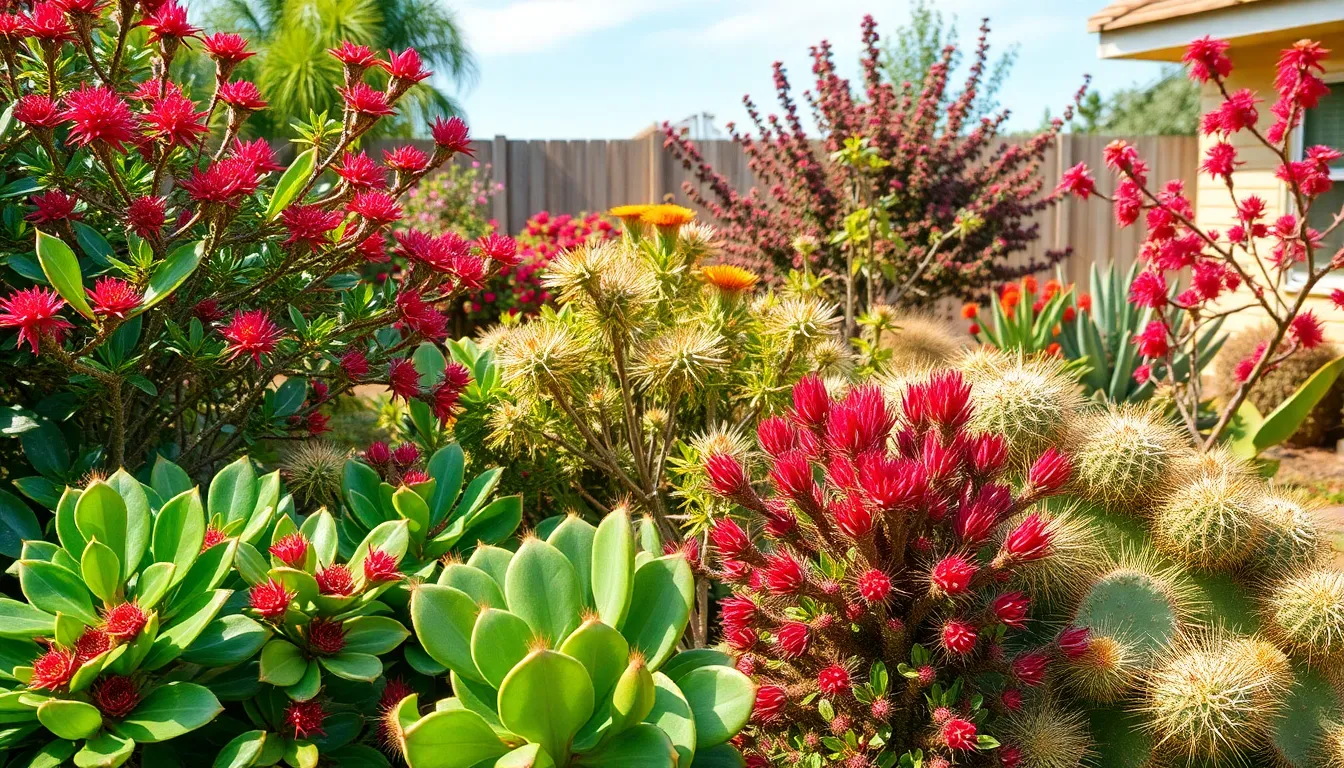
Physical barriers work just as effectively as aromatic deterrents when it comes to protecting our gardens from deer damage. Plants with sharp thorns, spiky leaves, and prickly textures create natural obstacles that deer simply won’t navigate through.
Barberry Bushes
Barberry bushes rank among the most effective thorny plants for deer deterrence due to their sharp, needle-like thorns that cover every branch. We recommend planting these hardy shrubs as natural fencing around vulnerable garden areas, where their dense, spiny growth pattern creates an impenetrable barrier that deer actively avoid. Japanese barberry (Berberis thunbergii) and European barberry varieties offer year-round protection while adding colorful foliage that ranges from deep red to bright yellow. These low-maintenance shrubs thrive in various soil conditions and provide excellent coverage for protecting more delicate plants behind them.
Holly and Juniper Varieties
Holly plants (Ilex species) feature glossy leaves with sharp, pointed edges that make them naturally deer-resistant throughout all seasons. American Holly (Ilex opaca) stands out as particularly effective, with its thick, waxy leaves and spiny margins that deer find uncomfortable to navigate. Juniper varieties complement holly plantings perfectly, offering needle-like foliage that creates an equally unwelcoming texture for browsing animals. Eastern Red Cedar and Chinese Juniper provide dense, evergreen coverage that maintains its protective qualities year-round. We’ve found that combining these two plant types creates layered defense systems that effectively discourage deer from entering protected garden spaces.
Cactus and Succulent Options
Cactus plants and thick-leaved succulents offer unique answers for deer-resistant landscaping in warmer climates and drought-prone areas. Prickly pear cactus varieties provide both ornamental value and complete deer protection with their dense clusters of sharp spines. Agave plants create striking focal points while their thick, sword-like leaves with razor-sharp edges naturally repel deer and other browsing animals. Barrel cactus and cholla varieties work exceptionally well in xeriscaped gardens, requiring minimal water while providing maximum deer deterrence. We recommend grouping these plants together to create desert-themed garden sections that deer will instinctively avoid due to their intimidating textures and defensive structures.
Perennial Flowers That Deer Will Not Eat

Beyond the fragrant herbs and spiky deterrents we’ve explored, perennial flowers offer lasting beauty while naturally repelling deer. These flowering plants return year after year, providing consistent protection through their aromatic qualities, toxic properties, or unappealing textures.
Marigolds and Strong-Scented Blooms
Marigolds stand out as one of the most reliable deer-resistant flowers due to their distinctive pungent scent that deer instinctively avoid. Signet marigolds offer a lighter citrus fragrance while maintaining their deer-repelling properties, making them popular choices for both ornamental and culinary gardens. These vibrant blooms flourish from late spring until the first frost, thriving in full sun conditions and requiring minimal maintenance.
Strong-scented companions enhance the protective barrier when we interplant marigolds with aromatic herbs like mint, thyme, French tarragon, chives, and sage. This combination creates multiple sensory deterrents that reinforce deer avoidance throughout the growing season. Regular deadheading keeps marigolds blooming continuously, extending their protective coverage while maintaining garden aesthetics.
Foxglove and Digitalis
Foxglove contains natural toxic compounds that make these tall, elegant flowers completely unpalatable to deer, providing reliable protection without additional effort. Digitalis purpurea produces striking bell-shaped blooms that add vertical interest to garden borders while serving as effective natural barriers. The plant’s inherent toxicity ensures deer recognize and avoid these areas, protecting surrounding vulnerable plants.
Careful placement maximizes foxglove’s protective benefits when we position these perennials strategically around garden perimeters or near plants that typically attract deer. Their impressive height creates visual screens while establishing scent boundaries that deer respect. Garden maintenance remains simple since the plant’s natural defenses require no supplemental treatments or frequent replacement.
Peony and Iris Varieties
Peonies offer spectacular spring blooms while maintaining deer resistance through their chemical makeup and foliage characteristics that deer find unappetizing. These long-lived perennials establish strong root systems that support decades of reliable flowering and protection. Various peony types, from herbaceous to tree peonies, provide options for different garden styles and growing conditions.
Iris varieties complement peonies perfectly with their sword-like foliage and diverse bloom colors that deer consistently avoid browsing. Many iris species thrive in different moisture conditions, from bog irises in wet areas to bearded irises in well-drained soils. Both plant families require minimal care once established, making them practical choices for low-maintenance deer-resistant gardens.
Native Plants That Naturally Repel Deer
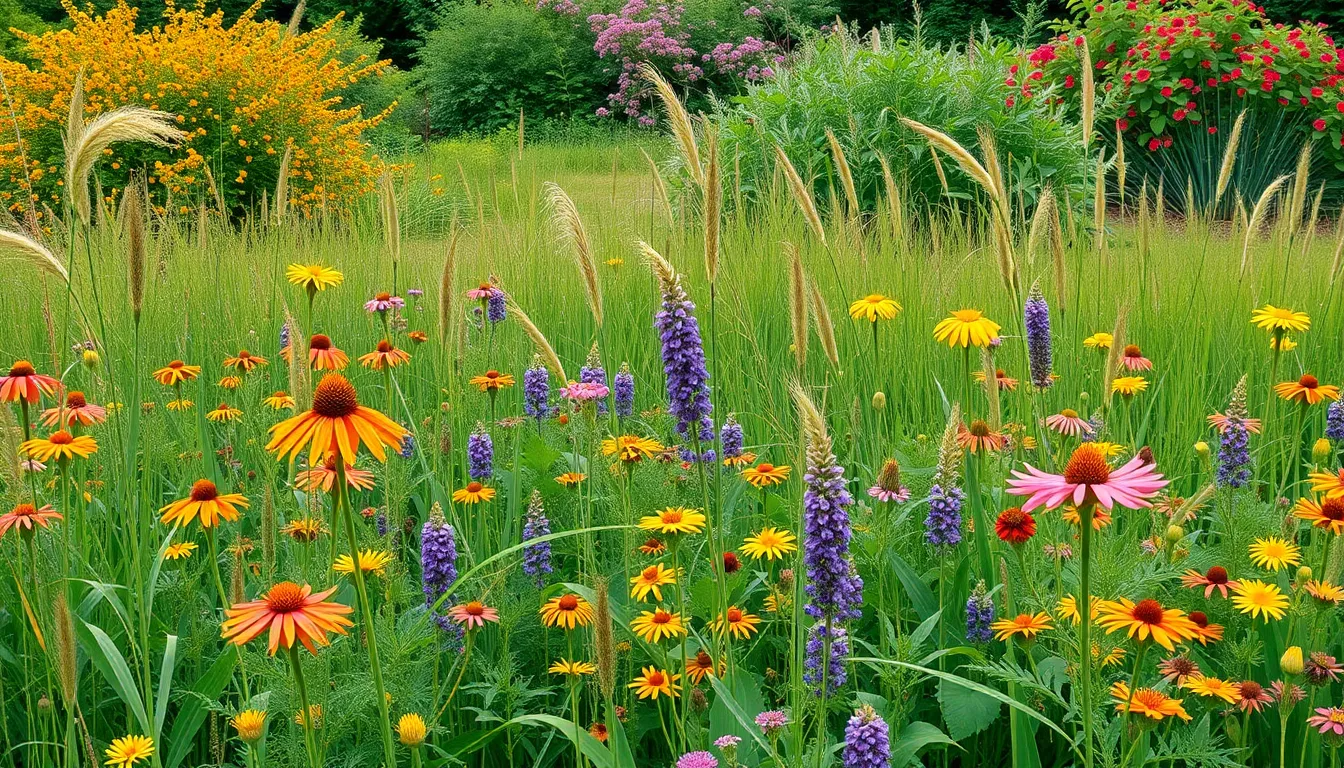
Native plants offer the perfect combination of natural deer resistance and ecological benefits for our gardens. These indigenous species have evolved alongside local wildlife and possess inherent characteristics that make them naturally unappealing to deer.
Regional Wildflowers and Grasses
Butterfly milkweed stands out as one of the most reliable deer resistant wildflowers due to its bitter taste that deer instinctively avoid. We can count on swamp milkweed to provide similar protection while supporting monarch butterflies and other pollinators in our landscapes.
Native grasses create excellent natural barriers without requiring constant maintenance or replacement. Little bluestem grass offers tough textured foliage that deer find unappealing while providing valuable habitat for birds and beneficial insects. Switchgrass works equally well as a deer deterrent and supports local wildlife populations throughout the growing season.
Eastern coneflower, black eyed Susan, and cut leaved coneflower represent proven deer resistant options that the University of Maryland Extension specifically recommends for problem areas. Goldenrod species including early goldenrod, gray goldenrod, and wrinkleleaf goldenrod provide late season color while remaining untouched by browsing deer.
Native ferns such as western maidenhair fern create texture rich plantings that deer typically avoid due to their unique leaf structure and growth patterns.
Indigenous Shrubs and Bushes
Bayberry delivers excellent deer protection through its aromatic leaves and resinous coating that creates an unpalatable browsing experience. We find this native shrub particularly effective along property borders where deer pressure tends to be highest.
Spicebush uses strong aromatic qualities to naturally repel deer while providing early spring blooms and fall color for our native plant gardens. Red chokeberry and black elderberry offer similar deer resistance combined with seasonal interest and wildlife benefits.
Black haw provides reliable deer protection across many U.S. regions while producing attractive spring flowers and fall berries for birds. American holly creates an impenetrable barrier with its spiny leaves that physically deter deer from approaching vulnerable plants behind it.
Local Tree Species
Pitch pine represents an excellent choice for areas where we need both deer resistance and year round screening. Sweet bay magnolia combines deer resistant qualities with fragrant spring blooms and attractive evergreen foliage in warmer climates.
Sweet gum trees work particularly well in Coastal Plain regions where deer populations can be especially problematic for gardeners. Red cedar provides moderate deer resistance, though we should note that deer may browse lower twigs when populations become extremely high in the area.
Black locust creates natural barriers through its spiny branches and pods that deer generally avoid, making it useful for property boundaries and problem zones where deer damage has been severe.
Ornamental Grasses Deer Avoid
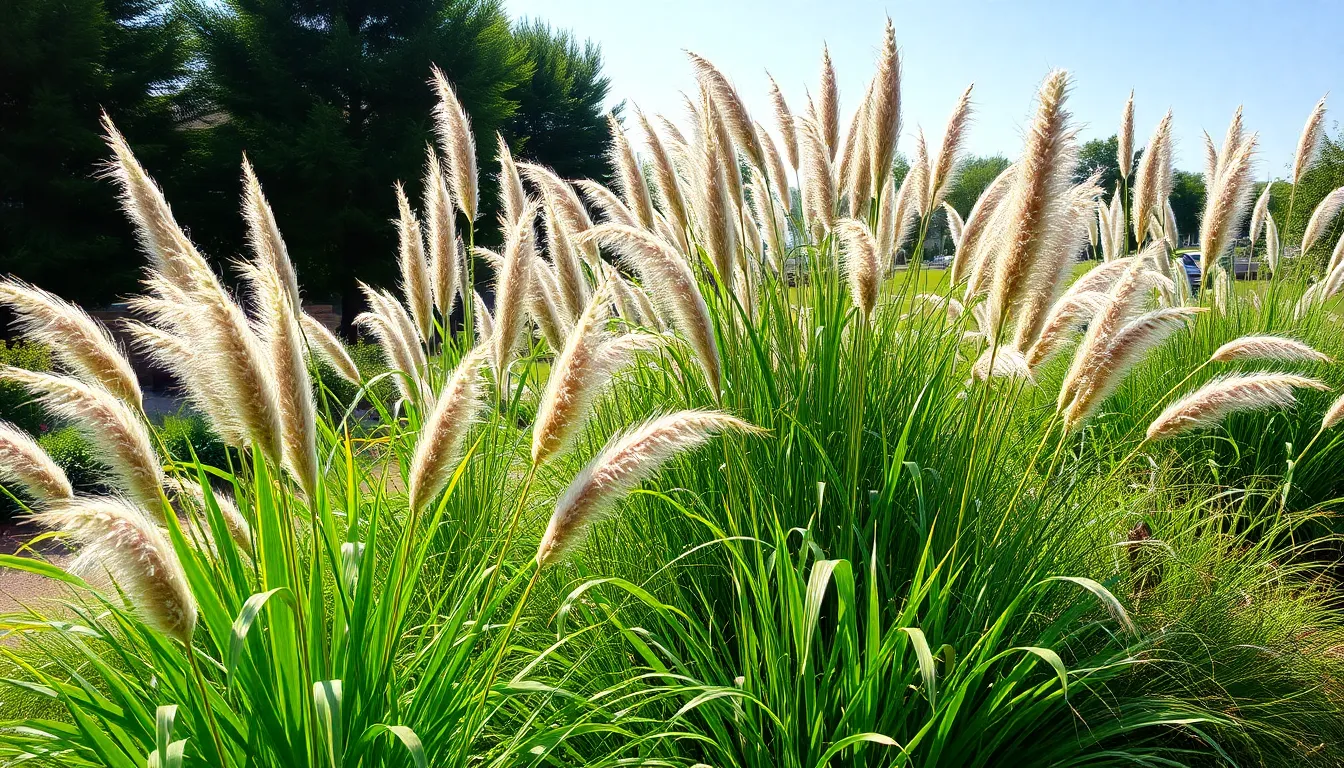
Ornamental grasses provide exceptional texture and movement to landscapes while naturally deterring deer through their coarse, fibrous foliage and sharp edges. We recommend these grass varieties for gardeners seeking low maintenance deer resistance without sacrificing visual appeal.
Fountain Grass and Pampas Varieties
Fountain Grass (Pennisetum species) creates stunning garden displays with soft, flowing foliage and feathery flower spikes that deer consistently avoid. These grasses possess unique textures and flavors that make them unappealing to browsing animals. We’ve observed fountain grass thriving in gardens where deer frequent other areas, proving its effectiveness as a natural deterrent.
Pampas Grass (Cortaderia selloana) stands tall with dramatic plumes and sturdy leaves that deer instinctively avoid due to their sharp edges and tough composition. Its impressive height and architectural presence make it an excellent focal point while providing reliable deer protection. We recommend planting pampas grass in areas where you want both visual impact and natural deer barriers.
Ornamental Sedges
Ornamental Sedges offer grass-like appearances with firm, blade-like leaves that deer find unpalatable and difficult to digest. Their fibrous texture creates an uncomfortable browsing experience that deer quickly learn to avoid. We particularly value sedges for their versatility in various growing conditions, from wet areas to dry slopes.
Different sedge varieties provide unique textures and colors while maintaining consistent deer resistance throughout the growing season. Some species feature sharp leaf margins that physically deter deer, while others produce compounds that create bitter tastes. We find sedges especially useful for naturalizing areas where traditional lawn grass struggles to establish.
Decorative Reed Grasses
Reed grasses feature stiff stems and coarse foliage that deer find both unappetizing and uncomfortable to navigate. Their dense growth habits create physical barriers that discourage deer from entering planted areas. We recommend using decorative reed grasses along property borders where deer typically enter gardens.
Various reed grass species develop robust root systems and tall growth patterns that create effective natural screens while deterring deer browsing. Their winter interest adds seasonal appeal when many other plants have died back. We’ve successfully used reed grasses to protect more vulnerable plantings by creating buffer zones that deer prefer to avoid entirely.
Vegetables and Edibles That Deer Will Not Eat
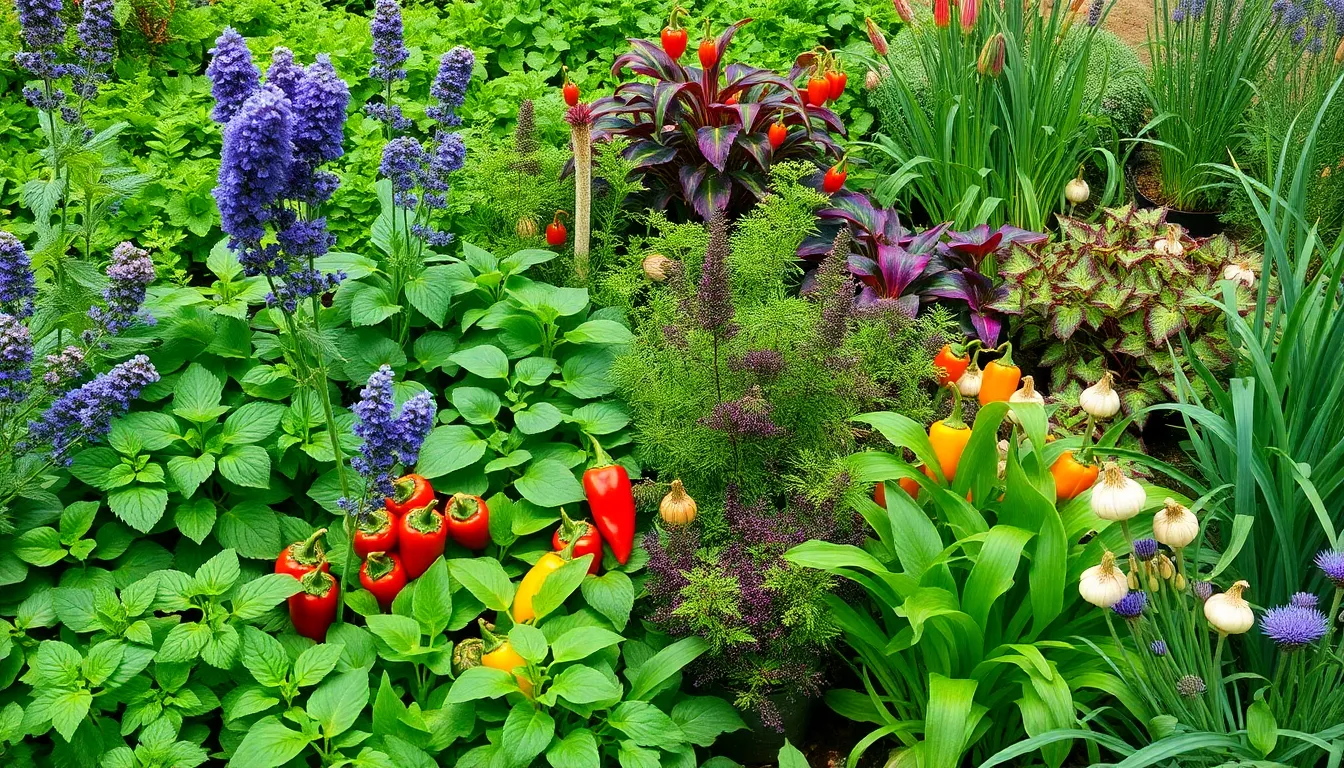
Growing our own food doesn’t mean we have to sacrifice it to hungry deer. Strategic selection of naturally deer resistant edibles can protect our vegetable gardens while providing us with fresh ingredients for cooking.
Strongly Flavored Herbs for Cooking
Aromatic perennial herbs create powerful natural barriers that deer instinctively avoid due to their strong scents. Mint varieties produce concentrated oils that overwhelm deer’s sensitive noses, making them excellent border plants around vulnerable vegetables. Thyme releases its potent fragrance when brushed against, creating an unfavorable browsing environment that deer quickly learn to avoid.
French tarragon offers both culinary value and deer protection with its distinctive anise-like aroma that deer find unpalatable. Lavender serves double duty as a beautiful flowering herb and reliable deer deterrent, with its essential oils providing long-lasting protection throughout the growing season. Chives from the onion family deliver sharp, pungent scents that signal danger to deer, while sage produces compounds that deer recognize as undesirable food sources.
Interplanting these aromatic herbs throughout our gardens creates multiple scent barriers that effectively reduce deer damage while providing us with fresh cooking ingredients year-round.
Onion Family Plants
Members of the Allium species naturally repel deer through their sulfur compounds and intense flavors that deer find completely unappealing. Garlic produces allicin and other organosulfur compounds that create an offensive odor barrier deer won’t cross. Onions release similar chemical deterrents when their foliage is disturbed, warning deer away from surrounding plants.
Chives combine the protective qualities of the onion family with easy growing habits, making them perfect companion plants for more vulnerable vegetables. Shallots and leeks extend this natural protection while providing us with gourmet cooking options that deer consistently avoid. Society garlic and ornamental alliums offer additional choices for creating attractive, deer resistant edible landscapes.
These allium varieties thrive in most garden conditions and return year after year, providing reliable deer protection without requiring replanting or maintenance.
Hot Peppers and Spicy Varieties
Capsaicin and related compounds in spicy plants create intense burning sensations that deer’s taste receptors cannot tolerate. Hot peppers produce these natural deterrent chemicals in concentrations that immediately signal danger to browsing deer. Jalapeños, serranos, and habaneros all contain sufficient capsaicin levels to effectively repel deer while providing us with flavorful additions to our meals.
Cayenne peppers and Thai chilies offer even stronger protection due to their higher capsaicin content, creating zones that deer learn to avoid completely. Sweet peppers with spicy varieties nearby benefit from this protection, as deer typically avoid entire areas where they detect these compounds. Spicy varieties of common vegetables like radishes and mustard greens also deter deer through their natural pungency and sharp flavors.
Growing these naturally spicy plants creates protective corridors throughout our gardens while ensuring we have fresh, flavorful ingredients for cooking that deer will never touch.
Evergreen Options That Resist Deer Damage
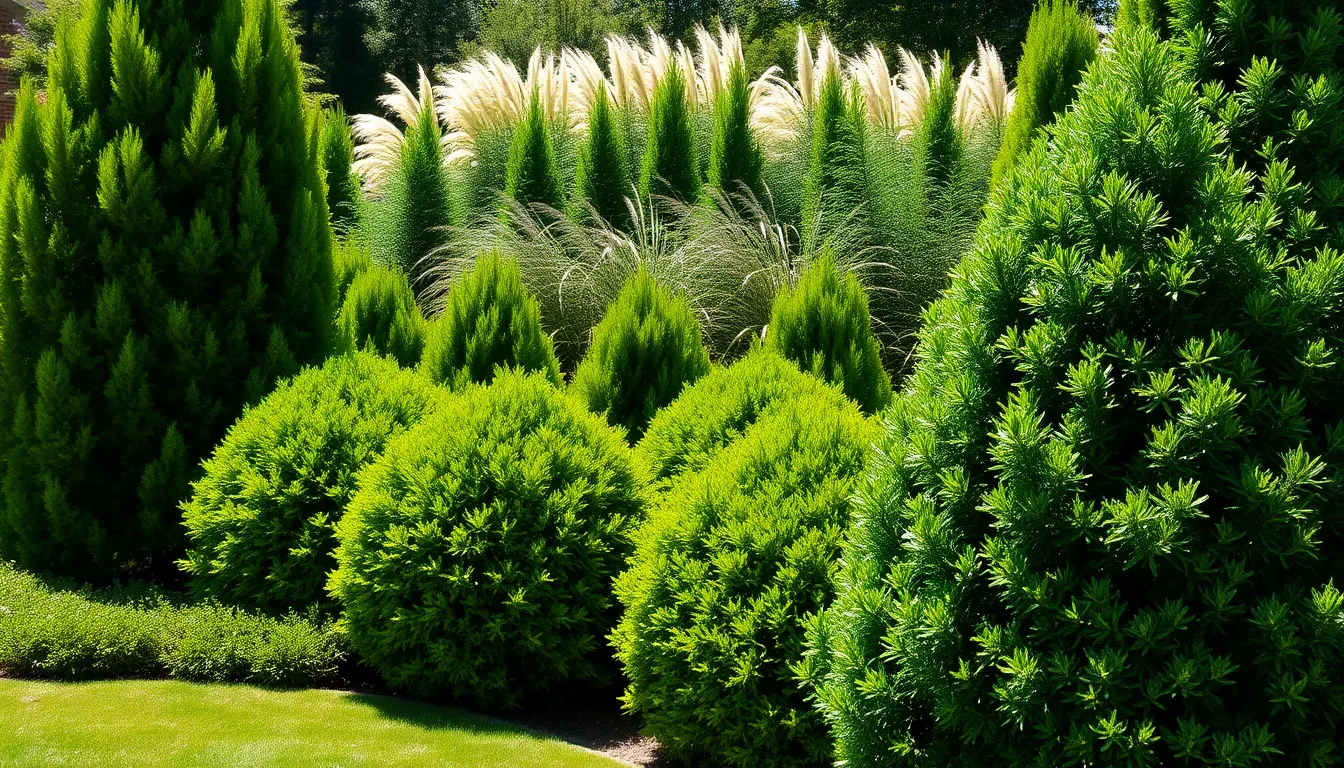
Evergreen plants offer the perfect solution for year-round deer protection while maintaining constant visual appeal in our gardens. These hardy selections combine natural deer resistance with the practical benefit of continuous foliage coverage.
Coniferous Trees and Shrubs
Junipers stand out as the most versatile deer-resistant conifers we can plant in our landscapes. Volatile oils in their needles create a natural barrier that deer instinctively avoid, while their drought-tolerant nature makes them practically maintenance-free. We can use these adaptable evergreens as groundcovers, accent plants, topiaries, or privacy screens depending on our exact garden needs.
Thuja ‘Green Giant’ Arborvitae delivers fast-growing privacy with exceptional deer resistance built right in. Strong scents from its dense foliage repel browsing animals while creating effective hedges and privacy screens. This evergreen tree grows quickly to establish natural barriers that protect more vulnerable plants behind them.
Chinese Junipers provide reliable shrub options for gardeners seeking deer-resistant hedge materials. Their compact growth habit makes them ideal for border plantings where we need consistent protection. These hardy conifers maintain their defensive properties year-round while requiring minimal care once established.
Boxwood and Hedge Plants
Boxwood varieties offer unmatched reliability for formal hedge applications that deer won’t disturb. Dense, leathery leaves combined with subtle aromatic compounds create an effective deterrent system. We can shape these evergreen shrubs into precise geometric forms or allow them to grow naturally as informal borders.
Compact evergreen leaves provide both privacy and structure without attracting unwanted wildlife visitors. Boxwood’s consistent growth pattern makes it perfect for creating defined garden rooms and property boundaries. These plants maintain their protective qualities throughout all seasons while supporting our industry design goals.
Harlequin Glorybower serves as an attractive hedge alternative with moderate deer resistance and seasonal flowering benefits. This shrub option diversifies our evergreen palette while maintaining protective properties. We can incorporate it into mixed hedge plantings for added visual interest and continued deer deterrence.
Year-Round Foliage Options
Aromatic herbs like Russian Sage, Lavender, and Salvia combine deer resistance with practical garden benefits throughout the growing season. Strong scents from these plants create unfavorable browsing conditions while providing us with fragrant foliage and seasonal blooms. Their tough leaf textures add another layer of natural protection against deer damage.
Ornamental grasses maintain year-round interest while offering textures that deer find unpalatable and uncomfortable. Many varieties provide continuous foliage coverage that serves as both decorative elements and protective barriers. We can use these grasses to create natural transitions between garden areas while maintaining deer resistance.
Spirea varieties deliver lasting foliage coverage with natural deer avoidance properties that protect surrounding plantings. These shrubs maintain their protective qualities through most of the year while offering seasonal flowering displays. We should select non-invasive species to ensure our deer-resistant plantings remain environmentally responsible choices.
Design Tips for Creating Deer-Resistant Gardens
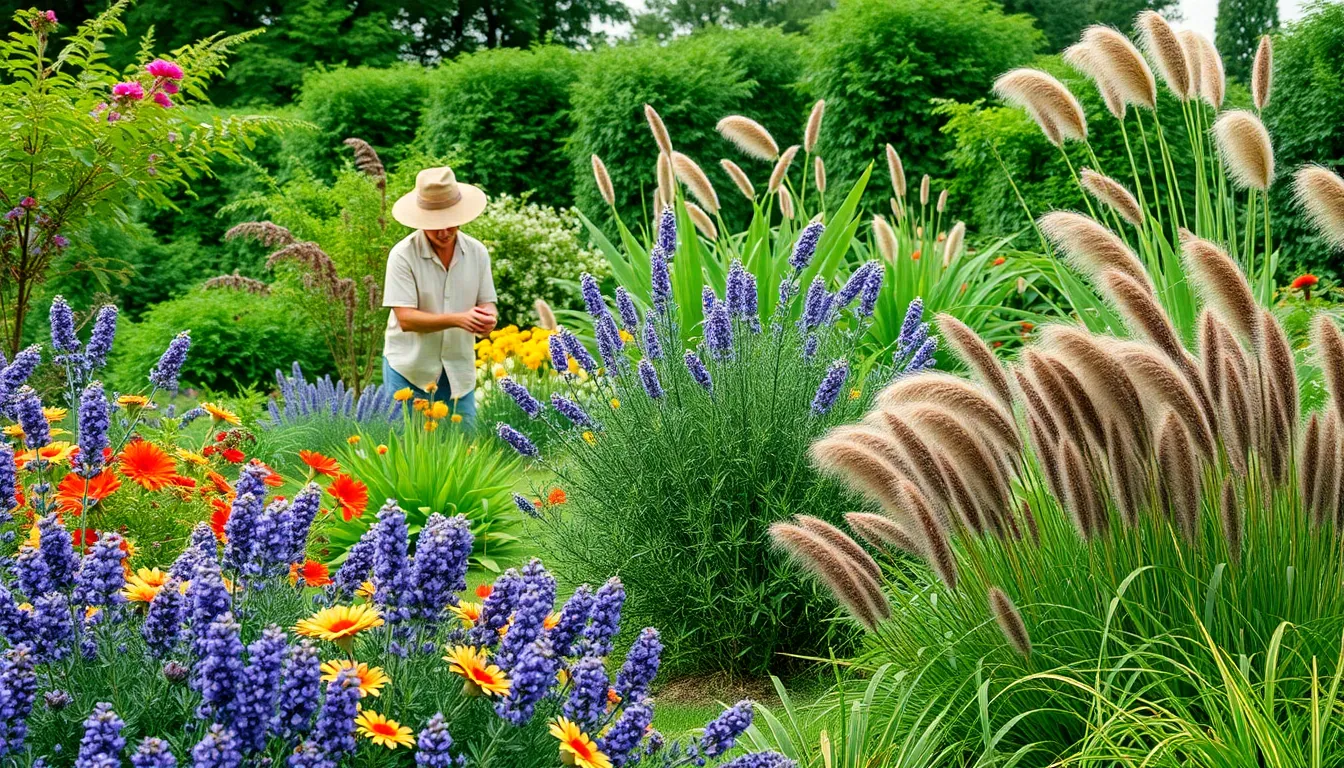
We’ve covered the best plants that deer won’t eat, but strategic garden design amplifies their effectiveness. Smart placement and thoughtful combinations create powerful barriers that protect our entire industry.
Strategic Plant Placement
Surround vulnerable plants with deer-resistant species to create natural protective barriers. We can place aromatic herbs like catmint and nepeta around our prized hostas or tulips, since deer dislike their strong scents and will avoid the entire area. Butterfly bush works exceptionally well as a perimeter plant, attracting pollinators while repelling deer with its aromatic foliage.
Position deer-resistant plants as focal points throughout the garden to reduce overall attractiveness to browsing animals. Boxwood shrubs make excellent cornerstone plantings due to their evergreen nature and strong scent that deer find offensive. Cinquefoil’s finely textured blue-green leaves create visual interest while deterring deer from settling in nearby areas.
Create layered defense systems by placing the most deer-resistant plants on the garden’s outer edges. We should establish borders with lavender, sage, and ornamental grasses before transitioning to more vulnerable plants in protected interior spaces. This approach guides deer away from our gardens before they can discover more palatable options.
Companion Planting Techniques
Mix aromatic herbs with showy perennials to confuse deer’s sensory systems while maintaining visual appeal. Sweet alyssum paired with gaura creates beautiful flowing combinations that deer rarely damage, according to resistance studies. These partnerships provide continuous blooms throughout the growing season while maintaining strong deterrent properties.
Combine plants with diverse textures and scents to create an unwelcoming environment for deer browsing. We can interplant fuzzy-leaved plants with thorny shrubs and aromatic herbs to overwhelm deer’s decision-making process. This sensory overload makes our gardens less attractive than simpler, more predictable food sources.
Establish fragrant barriers between garden sections using plants from the “Rarely Damaged” category in deer resistance research. Catmint and other nepeta varieties work particularly well as living fences, creating aromatic walls that deer won’t cross. These natural boundaries protect entire garden rooms without requiring physical barriers or chemical repellents.
Maintenance and Care Considerations
Provide proper growing conditions to maximize each plant’s natural deer-resistant qualities. Well-watered lavender and sage maintain stronger essential oil production, which intensifies their deer-repelling properties. Healthy plants recover quickly from any minor browsing damage and continue producing the compounds that keep deer away.
Prune aromatic plants regularly to encourage fresh growth and maintain peak scent production. We should trim butterfly bush and other fragrant shrubs after blooming to promote new shoots with concentrated aromatic oils. This maintenance practice ensures our deer deterrent plants remain effective throughout multiple growing seasons.
Monitor soil conditions and drainage to keep deer-resistant plants thriving in their preferred environments. Ornamental grasses and Mediterranean herbs perform best in well-draining soils, while maintaining vigor that helps them resist any browsing pressure. Strong, healthy plants produce more of the chemical compounds and physical characteristics that naturally deter deer feeding.
Conclusion
Creating a deer-resistant garden doesn’t mean sacrificing beauty or functionality. By carefully selecting plants with natural deterrent properties—whether they’re fragrant herbs sharp-textured grasses or thorny shrubs—we can maintain stunning landscapes that deer simply won’t touch.
The key lies in understanding what deer naturally avoid and using that knowledge to our advantage. From aromatic lavender borders to spiky barberry hedges these plants work as living barriers that protect our gardens year-round.
Remember that successful deer-resistant gardening combines multiple strategies. Layer different types of deterrent plants create natural barriers with companion planting and maintain your garden properly to maximize each plant’s protective qualities.
With the right plant choices and thoughtful design we can enjoy thriving gardens that feed our families and delight our senses—not the local deer population.
Frequently Asked Questions
What makes certain plants deer-resistant?
Deer-resistant plants naturally deter deer through strong scents, bitter tastes, or tough textures. Aromatic plants like lavender and rosemary create natural barriers with their oils, while toxic compounds in plants like foxglove make them unpalatable. Spiny, fuzzy, or thick-leaved plants also discourage deer from browsing due to their uncomfortable texture.
Which fragrant herbs are most effective at repelling deer?
Lavender, rosemary, thyme, sage, and catmint are highly effective deer deterrents. These Mediterranean herbs and mint family plants produce strong aromatic oils that deer instinctively avoid. They’re particularly valuable because they provide culinary benefits while creating protective barriers around more vulnerable garden plants.
Can spiky and thorny plants effectively deter deer?
Yes, physical barriers work excellently. Barberry bushes with sharp thorns, holly with pointed leaves, and juniper varieties create uncomfortable browsing conditions. In warmer climates, cacti and succulents like prickly pear and agave provide unique deer-resistant landscaping solutions while adding visual interest to gardens.
What perennial flowers naturally repel deer?
Marigolds, foxglove, peonies, and irises are excellent deer-resistant perennials. Marigolds have a pungent scent deer avoid, while foxglove contains toxic compounds. Peonies and irises have chemical compositions and foliage characteristics that naturally deter deer browsing while providing beautiful, low-maintenance garden displays.
Are there deer-resistant vegetables I can grow?
Absolutely! Strongly flavored herbs like mint, thyme, and French tarragon create natural barriers. Onion family plants including garlic and chives contain sulfur compounds that repel deer. Hot peppers with capsaicin are particularly effective, providing spicy ingredients for cooking while deterring deer completely.
Which ornamental grasses deter deer?
Fountain grass, pampas grass, and ornamental sedges work well due to their coarse foliage and sharp edges. Their fibrous textures create uncomfortable browsing experiences, while decorative reed grasses form dense growth habits that discourage deer from entering planted areas while adding movement and texture.
What evergreen options resist deer damage?
Coniferous trees and shrubs like junipers and Thuja ‘Green Giant’ Arborvitae provide year-round barriers. Boxwood varieties create excellent formal hedges with their dense, leathery leaves. These evergreens offer continuous visual appeal, privacy, and low-maintenance deer protection throughout all seasons.
How should I design a deer-resistant garden?
Use strategic plant placement and companion planting techniques. Surround vulnerable plants with deer-resistant species to create protective barriers. Place fragrant plants along garden borders and entry points. Interplant aromatic herbs with other plants to enhance their protective qualities while maintaining aesthetic appeal.

